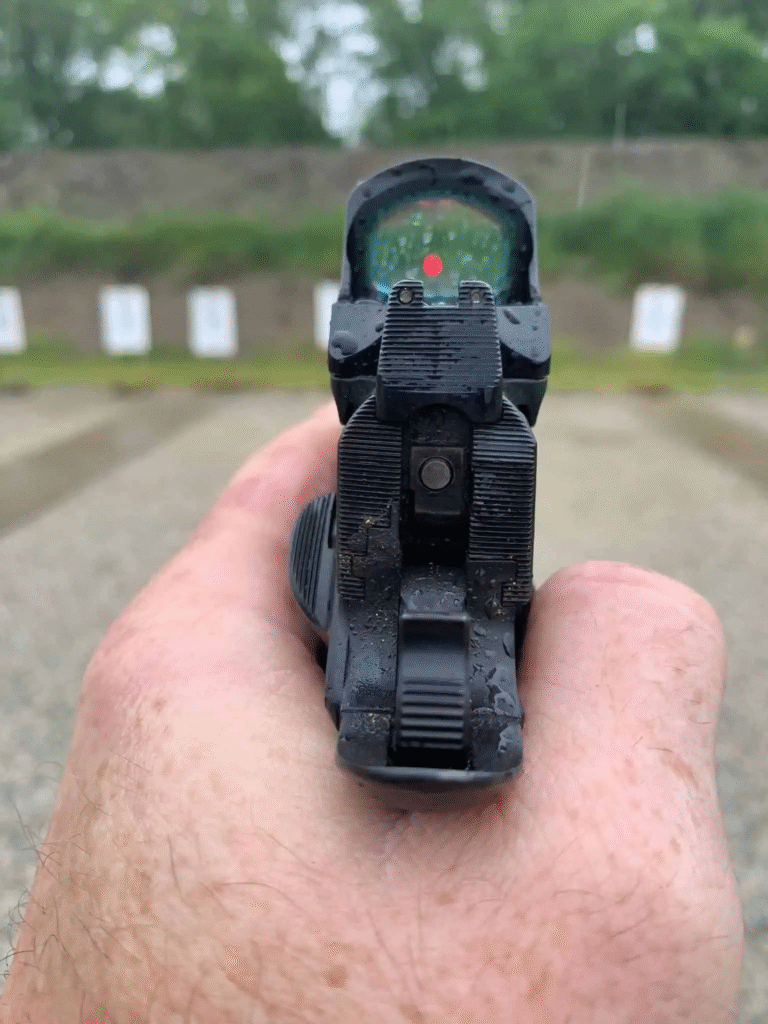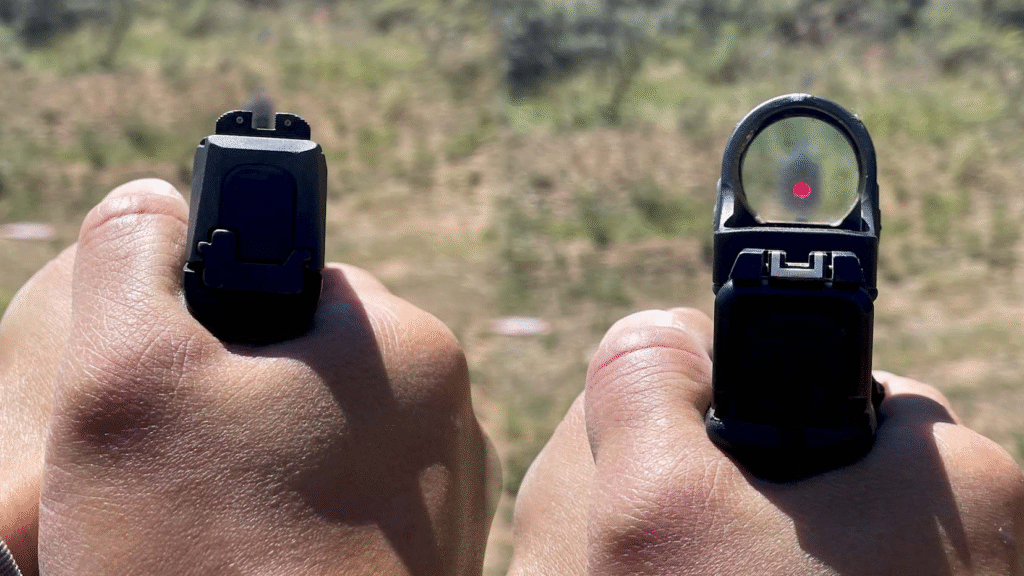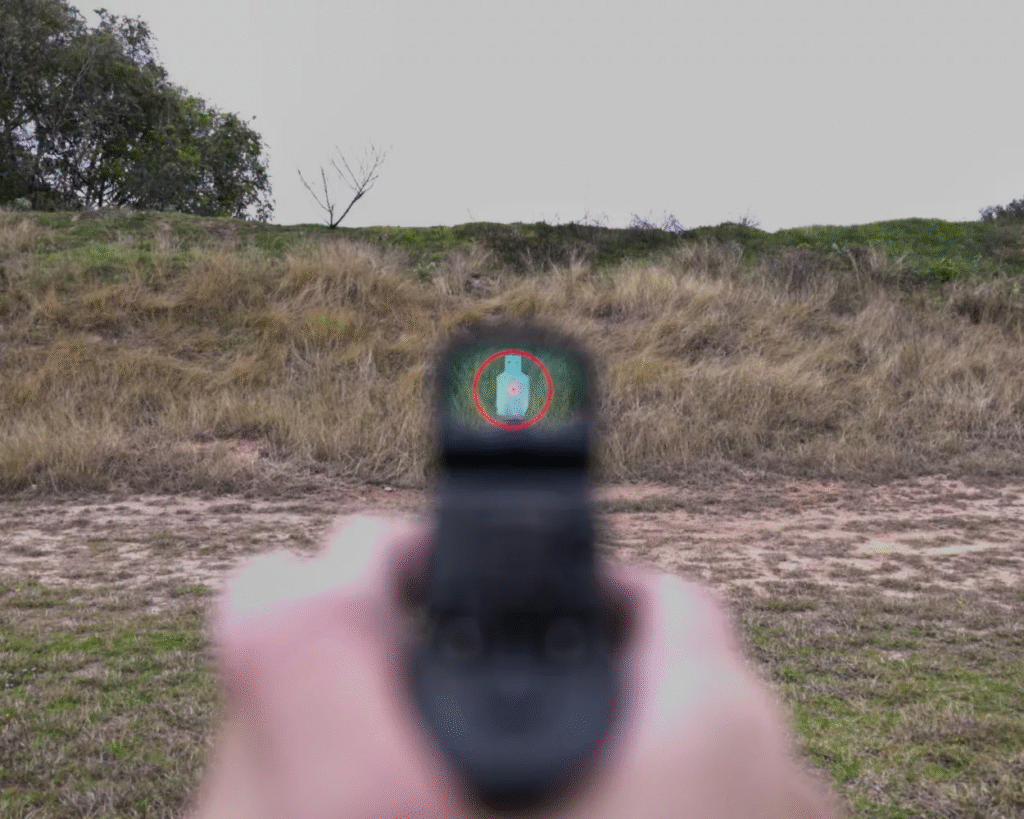Red dot optics on pistols used to be rare. Today, they’re becoming the standard. From concealed carriers to competitive shooters to law enforcement, more people are making the switch. Still, there’s plenty of pushback — and most of it comes from persistent myths.
At Suburban Protector, we’ve trained hundreds of shooters across Boynton Beach, Delray Beach, West Palm Beach, Boca Raton, and South Florida. Time and again, we’ve seen skeptics turn into believers once they get real training with a pistol-mounted optic.
Let’s bust six of the most common myths about red dots — and explain why you should consider one for your own carry gun.

Myth 1: “Red Dots Are Too Hard to Learn”
One of the biggest myths is that red dots take forever to learn. New shooters often struggle to “find the dot” when presenting the gun, leading to frustration.
The Truth: The learning curve is real, but it’s short with proper training. The issue isn’t the dot — it’s presentation. If your draw stroke and grip are consistent, the dot appears naturally.
Training Tip: Start by bringing the gun to your line of sight instead of chasing the dot. Dry fire presentations from concealment are the fastest way to build this skill.
My Experience: I’ve had students in Boynton Beach who were skeptical on day one. By the end of a single session with dry fire and live reps, they were faster and more accurate than with irons.

Myth 2: “Iron Sights Are Faster”
Many shooters believe iron sights are quicker because they’ve trained with them for years.
The Truth: Under stress, the red dot is faster once you’ve trained the fundamentals. Your eyes naturally focus on the threat while the dot overlays the target. With irons, your focus must bounce between rear sight, front sight, and target — a slower process when adrenaline is pumping.
Training Tip: Run timed “draw-to-first-shot” drills with both irons and red dots. Most students see significant improvement with the dot after just a few practice sessions.

Myth 3: “Red Dots Fail Too Often”
Battery life, glass fogging, and electronic malfunctions are common concerns. Some shooters fear relying on technology.
The Truth: Modern red dots are extremely reliable. Quality optics from reputable brands run for thousands of hours on a single battery. Many models even feature auto-shutoff and shake-awake functions. Plus, most red dot setups include co-witnessed backup iron sights.
Training Tip: Change your battery once a year, just like replacing smoke detector batteries. Train occasionally with the dot turned off so you’re comfortable using your irons if needed.

Myth 4: “Red Dots Don’t Work for Concealed Carry”
Some argue that red dots are too bulky or snag on clothing during the draw.
The Truth: Today’s optics are designed for concealed carry. Slim, durable, and snag-free designs are the norm. Holster makers now offer countless red dot–compatible options, making concealment just as easy as with iron-sight pistols.
Training Tip: Practice clearing cover garments and drawing with your optic-equipped pistol. Once you build the reps, you’ll see there’s no practical disadvantage.

Myth 5: “You’ll Lose the Dot Under Stress”
Critics claim the red dot “disappears” in a fight.
The Truth: If you lose the dot, it’s a training issue, not an equipment issue. A consistent draw stroke puts the optic in front of your dominant eye every time. With proper training, the dot is easier to track under recoil than front sight focus.
Training Tip: Run failure-to-stop drills with par times. The stress of the clock mimics adrenaline and forces you to track the dot across multiple shots.
My Experience: In our tactical firearms training in South Florida, students quickly learn that once they master grip and presentation, the dot is easier to maintain than irons, even under stress.

Myth 6: “Red Dots Are Only for Pros”
Some shooters think red dots are reserved for competitive or tactical professionals.
The Truth: Red dots are one of the biggest performance boosts for everyday concealed carriers. They extend your effective range, improve low-light shooting, and build confidence in stressful situations.
Training Tip: Don’t wait until you’re “good enough” with irons to switch. If your end goal is to run a red dot, start now and learn it correctly from the beginning.

My Experience Teaching the Transition
Over the past several years, I’ve introduced red dots to dozens of students in Boynton Beach and throughout South Florida. Almost every time, the story is the same:
- At first, they’re frustrated by “not finding the dot.”
- After a short block of dry fire and structured drills, the dot appears naturally.
- By the end of the session, they’re shooting faster, more accurately, and with greater confidence than they did with irons.
The key is guided training, not just bolting on an optic and hoping it works.
Why You Should Consider One Anyway
Red dots aren’t a fad. They’re the future of pistol shooting. Law enforcement agencies across the country are transitioning to them, competitive shooters rely on them, and civilian carriers are seeing the benefits daily.
If you carry a firearm in Boynton Beach, Delray Beach, West Palm Beach, or Boca Raton, you owe it to yourself to explore the advantages of a red dot. With proper training, it’s not just a performance upgrade, it’s a life-saving advantage.
📅 Ready to make the switch?
Join us at Suburban Protector for advanced pistol and concealed carry training. Our instructors will guide you through the transition, shorten the learning curve, and give you the confidence to run your optic-equipped pistol under stress.
Whether you’re new to red dots or looking to sharpen your skills, we’ll help you train smarter and carry with confidence in South Florida.

